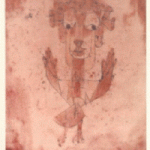 Walter Benjamin is the prophet of Scrounge Scatter. The German critic of things broken, Benjamin embodies the true spirit of Modernism. Susan Sontag quipped that his essays end just before they self-destruct. But not before I’m lulled to sleep, usually. He’s the philosopher in search of an interpreter who will synthesize his scattered observations. In other words, he is the must-cite (site) for any post- or post post- critical theory—or critique thereof. His famous essay “Art in the Age of Mechanical Reproduction†speaks volumes in its title alone, even before the age of endless links.
Walter Benjamin is the prophet of Scrounge Scatter. The German critic of things broken, Benjamin embodies the true spirit of Modernism. Susan Sontag quipped that his essays end just before they self-destruct. But not before I’m lulled to sleep, usually. He’s the philosopher in search of an interpreter who will synthesize his scattered observations. In other words, he is the must-cite (site) for any post- or post post- critical theory—or critique thereof. His famous essay “Art in the Age of Mechanical Reproduction†speaks volumes in its title alone, even before the age of endless links.
Benjamin’s Angel of History, based on an interpretation of Paul Klee’s Angelus Novus, stands breathless, back turned to the future, watching as the wreckage of the past piles up at his feet. Benjamin was chief forager in this cultural dustheap. I’ve spent the past week browsing an intriguing book, Walter Benjamin’s Archive: Images, Texts, Signs (Verso), drawn from the salvage of Benjamin’s odd collections and catalogs: notes, photos, picture postcards, toys, news articles and lists—endless lists, including, charmingly, the first words and phrases spoken by his son Stefan. Loads of it is reproduced (paper yellowed, cracked, water-stained, but without the archival dust that would have me wheezing and choking in a minute).
A short note titled “Excavation and Memory†contains this bit of Scatter lore:
Language has unmistakably made plain that memory is not an instrument for exploring the past, but rather a medium. It is the medium of that which is experienced, just as the earth is the medium in which ancient cities lie buried. He who seeks to approach his own buried past must conduct himself like a man digging. Above all, he must not be afraid to return again and again to the same matter; to scatter it as one scatters earth, to turn it over as one turns over soil.
These are images, treasures in a collector’s gallery. But it is not mindless scattering (and conjoining). There’s the time, place and circumstance of good historical research. We must mark “the exact location of where in today’s ground the ancient treasures have been stored up.†The investigative report on authentic memory documents the strata of origination, “but also gives an account of the strata which first had to be broken through.â€
Fragments, shards, shored against ruin, but tagged, referenced and carbon-dated.
(Compare the origin of Art Scatter.)
*Image: ”Angelus Novus”, Paul Klee (1920).